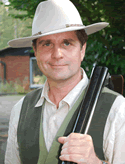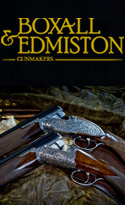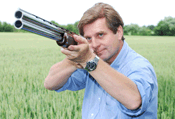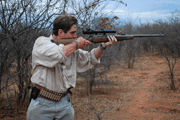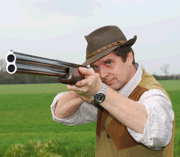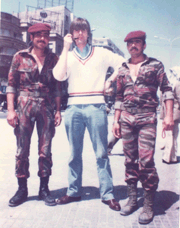Ten Reasons Why We Miss Pheasant
1) We stop the gun
Of all the mistakes when shooting driven game this is the number one cause of misses in my opinion. When I take note of my own shooting and that of other sportsmen, checking or hesitation allows more pheasants and other quarry to fly on than just about anything else. Of course, I am not alone in this opinion, Lord Ripon noted in King Edward VII as a Sportsman (Longmans, 1911): I will conclude these few remarks on the technique of shooting...with my favourite maxim: “aim high, keep the gun moving, and never check.”
I might add to the great shot's comments that I have noted that too long a stock can check the swing, as can a far forward hold on the forend, head raising, and a failure to lift the gun well with the front hand and push through as the shot is completed. You must also develop a stance which is comfortable and which allows you to keep moving on easily. For driven birds, for this reason, I favour keeping the feet quite close together, and, I move them whenever possible to facilitate the shot.
2) Taking one’s vision off the bird
In my book, the second, big sin, often related to the first, is failing to keep one’s eye or eyes locked onto the bird’s head though out the process of shooting. The importance of developing this skill – because it is nothing else – cannot be over-emphasised. It requires developed eye muscles and awareness of its importance. It is not a natural (instinctively we take our focus to a moving object, assess it's potential threat, and soften focus) and, requires training.
One must strive to achieve and maintain fine focus locked onto the bird though out the three seconds or so it usually takes to shoot a bird every time. If you do this, it will unlock phenomenal powers of natural hand to eye co-ordination. If you don’t, the swing will become hesitant and jerky, and, the wrong eye may take over if you shoot with both eyes open. You may also raise your head as noted which will cause the gun to rise and stop returning to point 1.
3) Correct lead is critical
Another very common error in all wingshooting is applying the wrong forward allowance either in error, or, as likely, because the shooter has insufficient experience of the sheer range of lead pictures required for different shooting situations. This begs a question, moreover. Should one be looking for lead deliberately on each shot?The answer, of course, is no. Usually, I prefer to take my muzzles to the tail feathers and push on instinctively. If the bird is high, I like to start a yard or two back from the bird rather than on the tail feathers. But, in all cases, I like to form some sort of muzzle-bird relationship with the selected quarry early in the process of shooting at it.
If I look for a lead picture deliberately, as I do on occasion – for example when wildfowling – I keep in mind that a typical bird 40 yards away wants about 6-8 feet or thereabouts. I do not, generally, look for a lead deliberately, just as I do not routinely maintain a deliberate lead. A more natural approach to lead, based, however, on well practised drills with regard to initial muzzle placement, seems to work better for me in most situations.
4) Line is as important as lead
Although errors of lead are common on the shooting field, misjudging a bird’s line is a frequent cause of missing as well. This is an interesting topic because it is often said by sophisticated shooters – ask the boys at West London or Hollands – that line is as important as lead, but, equally, one often here’s the dictum: “don’t cant.”
Well, it all depends on how you look at it. It is big mistake to cant the gun relative to the bird’s line. But, I frequently make an adjustment by twisting, i.e. canting, the gun to help follow its line. Give it a little thought in your mind’s eye (or better still, get out a proven empty gun and practise some of the basis movements).
In simple terms, driven birds may be shot without any noticeable twisting of the barrels within a certain arc to one’s immediate front – but, this arc it is quite tight – perhaps no more than 5 degrees to either side of centre. As soon as the bird moves significantly to the right or left, I like to adjust my barrels as I swing to match the bird. The idea is to keep the barrels of a side by side parallel to the bird’s line and the barrels of an over an under perpendicular. This is an active process. I sometimes call it ‘squaring up.’ It can be quite sublte sometimes.
5) Poor range estimation
Many birds are missed because the range of them is misjudged. This is not quite the same error as 3) – misjudging or not knowing the proper forward allowance in a particular situation. Let’s keep it simple: frequently, the height of pheasants is over estimated – which may cause misses in front as well as a tendency to lose or fail to achieve any sort of adequate muzzle quarry relationship initially.
Strangely, it is also a fact that many close, and apparently easy "I-wouldn’t-bother-raising-my-gun-to-that birds" are missed in front too. I have noticed this on numerous occasions when I have been standing on a peg with others. I shall not pass judgment on the sporting ethics – missing low flying poultry should cause enough chagrin of itself.
6) Poor footwork
Good shots usually have great gun mounts and good footwork too – they co-ordinate their lower body movements with the mount and swing. They take delicate little steps, barrels and front foot moving together when required, and, they don’t get wrong footed on many occasions. We all do sometimes, and, when it happens we end up shooting out of balance (of course, the best thing to do, and by far the safest, is not to shoot if out of balance, but sometimes it happens at the moment the trigger is pulled).
If you look at the typical pics of driven game shooters, you will note that those who are in perfect balance at the moment the shot is taken are in the minority. The simple rule is keep the front shoulder over the front foot – but it is easier said than done in a hot corner sometimes! One thing that I find helpful is to take some fast, unexpected, shots to the right by bringing my weight deliberately onto the right foot – not something I would normally do or advise for right-handers.
7) Bad timing
Some days everything seems to go like clockwork, on others, the time wheels fall off. It is an interesting subject and not as complicated as one might think. Most people who shoot well, shoot to three beats – One: Two: Three. Tempos change depending on the range, angle and speed of birds, but we should never lose that lovely, elegant, three beat timing: ONE:TWO:THREE not poke and hope!
8) Nervous tension
Some of us start to miss because we tense up. To shoot well, one wants to be bodily relaxed but positive of mind. One must commit to every safe shot, and, once committed, shoot decisively. Good shots really want to get their birds and can beat themselves up when they miss. I don’t advocate that you do the latter, but do maintain a positive mindset – you won’t be able to suppress all nerves, but you can use them in your favour. And, remember the effect of anxiety is to disrupt focus and smooth movement. Concentrate on these and you are more than half way to conquering your mind as well.
9) The last point leads on to this one. If you start to get flustered because you are missing, you will create a viscous circle becoming more tense and anxious. Flow will disappear from your shooting. The antidote is to relax and go back to essentials: muzzles to the tail feathers, push on, keep focussed on the beak as just discussed. Keep pushing through. Just putting all your attention into moving to the tail feathers and locking the focus onto the head and you move on smoothly will usually do the trick.
10) Finally, some miss birds because they are under (or, indeed, sometimes over) gunned. In recent years, I have increased my payloads significantly (32 grams in my norm) and gone up a pellets size (to 5 shot for most of my driven shooting). On tall birds, big pellets in larger number and a bit of choke definitely help.
I have managed to get this far without mentioned two of my favourite subjects much – eye dominance and gun-fit. It should go without saying that anyone with common sense who shoots regularly should be aware of the need for a occasion confirmatory checks of eye dominance and gunfit. A stock which is slightly too high, meantime, is much better to a game shot than one that is slightly too low (which may cause the wrong eye to take over in some circumstances). My last words? Stare each bird to death and keep the gun moving and on line...


